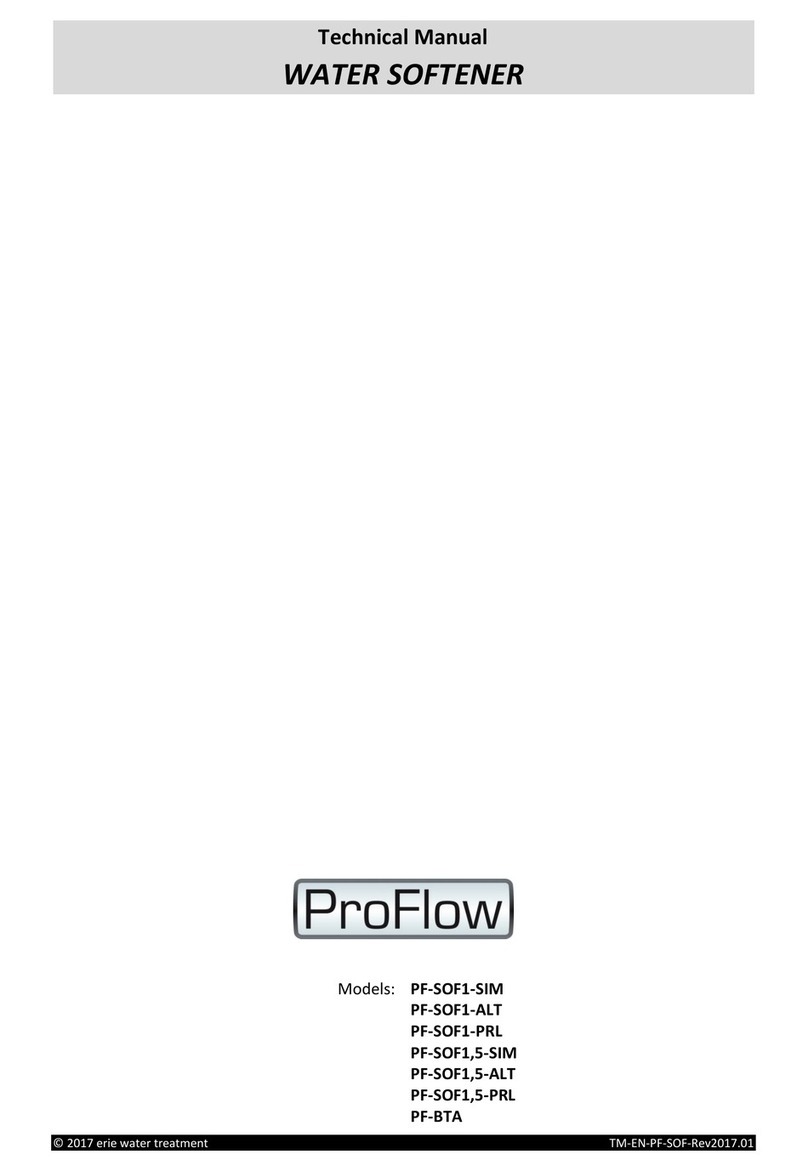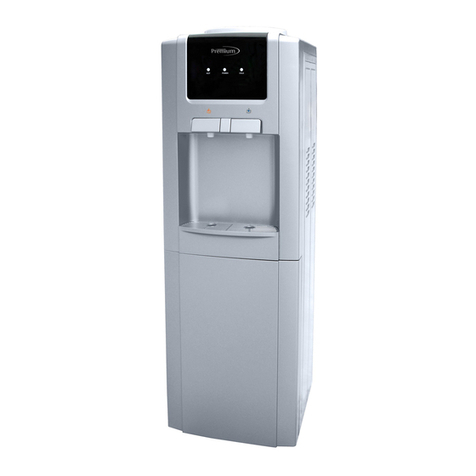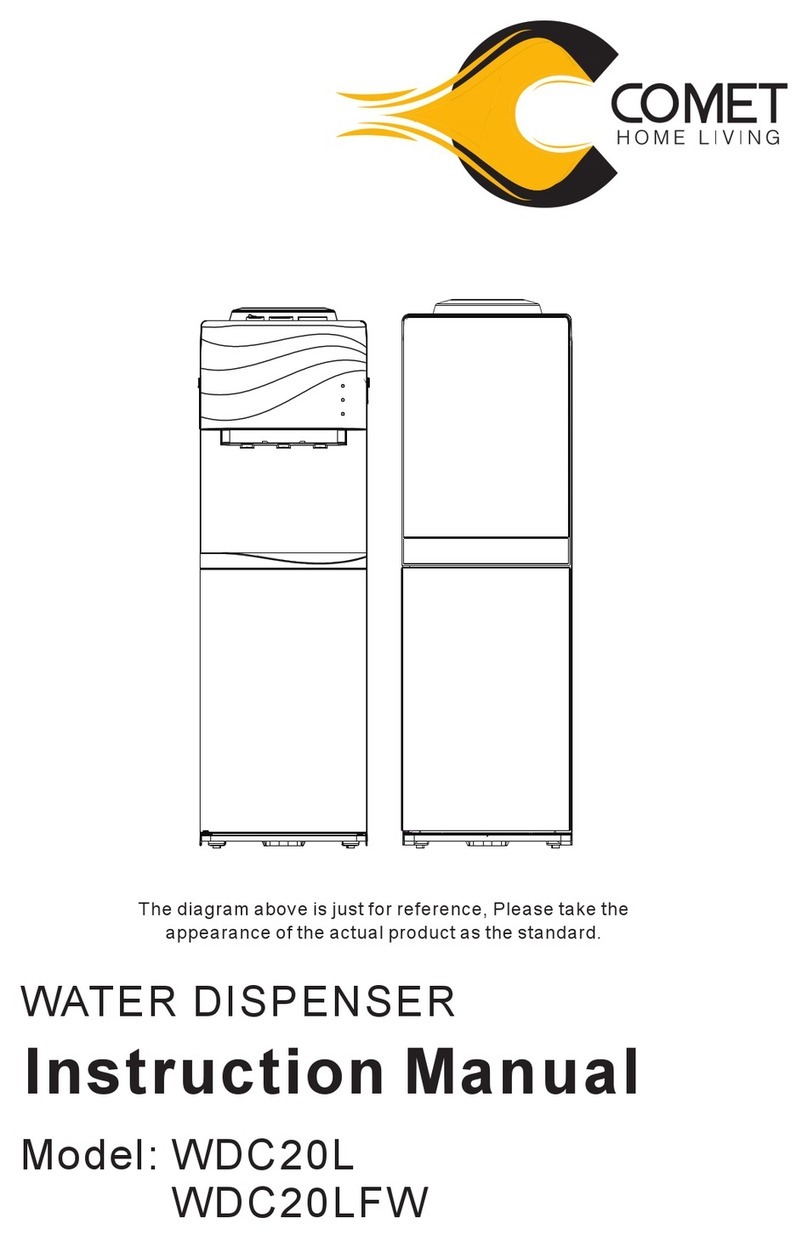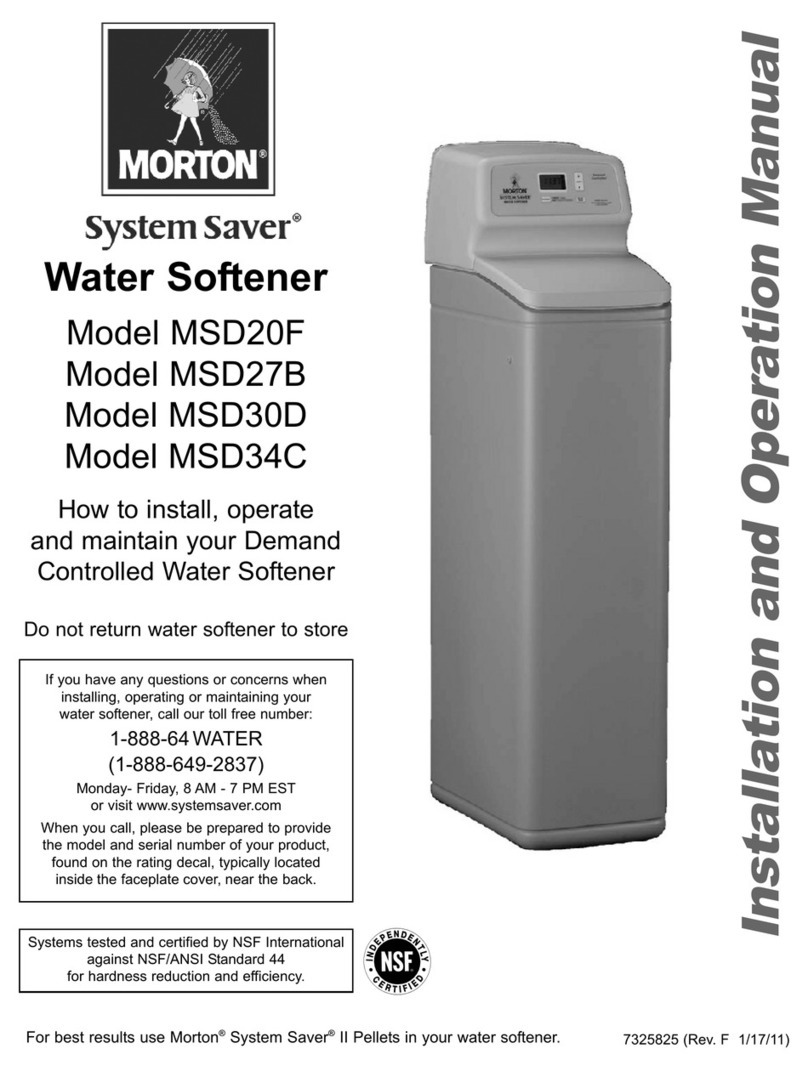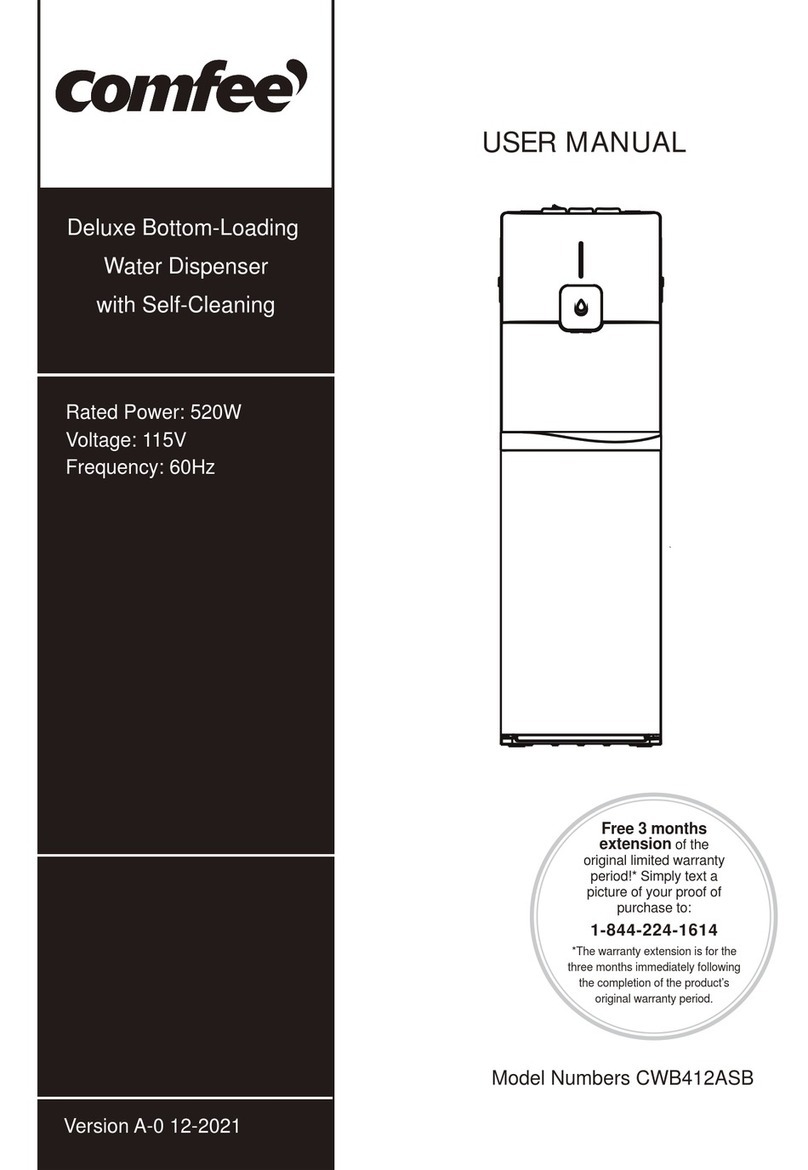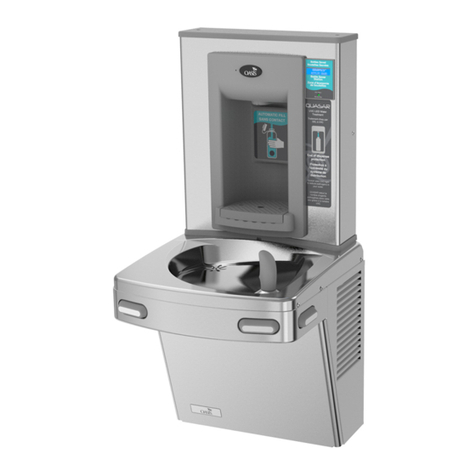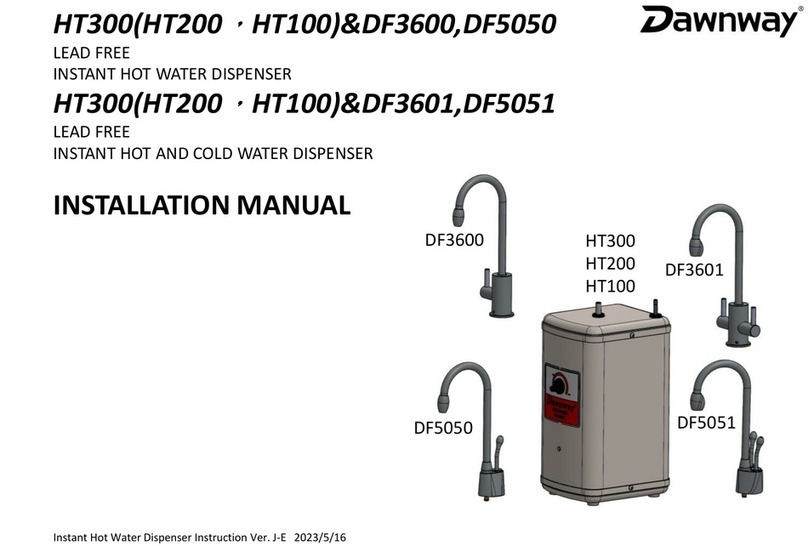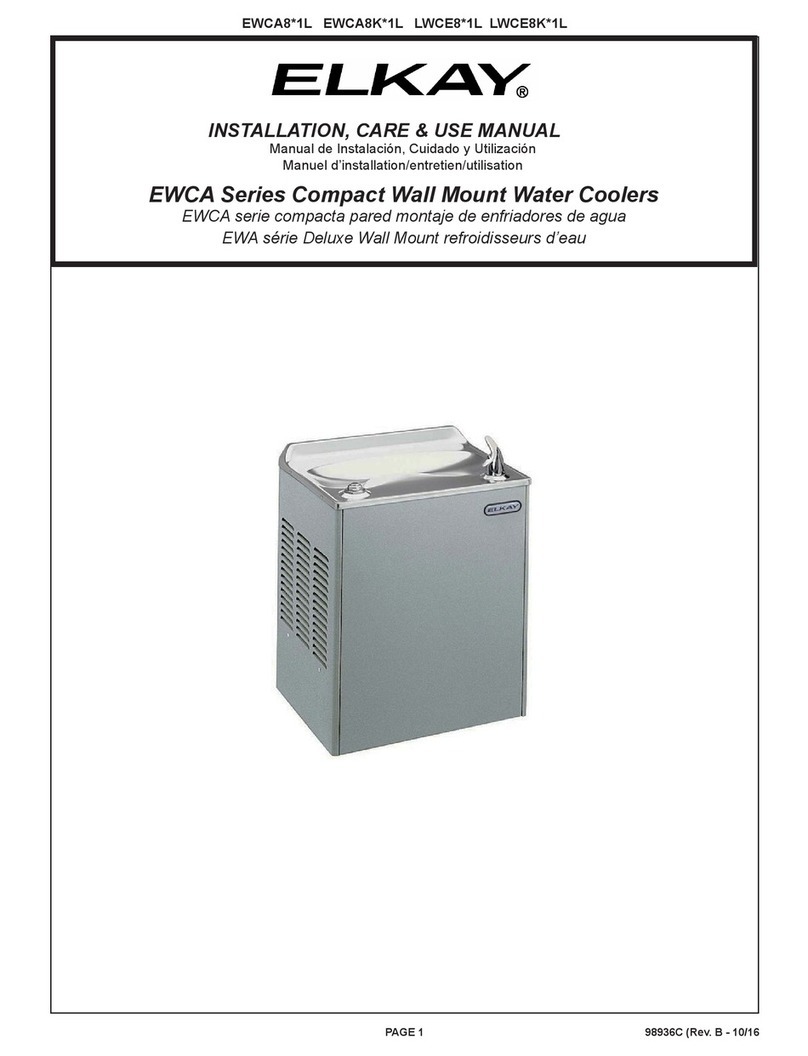ProFlow Water softener User manual

© 2013 Aquion, Inc. OM-ProFlow-Rev2013.03
EN
Installation & Operating Instructions
WATER SOFTENER
FR
Instructions d’Installation & Emploi
ADOUCISSEUR D’EAU
DE
Installation- & Gebrauchsanleitung
WASSERENTHÄRTER
NL
Installatie & Gebruiksinstructies
WATERONTHARDER
PL
Instrukcja Instalacji i Eksploatacji
ZMIĘKCZANIA WODY

EN English ........................................................................................................................Page 3
FR Français ......................................................................................................................Page 21
DE Deutsch ......................................................................................................................Seite 39
NL Nederlands.................................................................................................................Pagina 57
PL Polski ..........................................................................................................................Strona 75

TABLE OF CONTENT & INSTALLATION RECORD
Page 3 EN - English
Table of content & Installation record.....................................................................................Page 3
Warning & Safety instructions .................................................................................................Page 4
Operating conditions & Requirements ....................................................................................Page 5
Assembly ..................................................................................................................................Page 6
Installation ...............................................................................................................................Page 8
Start-up ....................................................................................................................................Page 10
Electronic control panel ...........................................................................................................Page 11
Maintenance ............................................................................................................................Page 17
Composition overview .............................................................................................................Page 18
Technical data ..........................................................................................................................Page 19
For future reference, fill in the following data
INSTALLATION RECORD
Serial number: _______________________________________________
Model: ________________________________________________________
Water hardness-inlet: _______________________________________
Water hardness-outlet: _____________________________________
Water pressure-inlet: ________________________________________
Date of installation: __________________________________________
Company name: _____________________________________________
Installer name: _______________________________________________
Phone number: ______________________________________________

WARNING & SAFETY INSTRUCTIONS
EN - English Page 4
Before you begin the installation of the water softener, we advise you
read and carefully follow the instructions contained in this manual. It
contains important information about safety, installation, use and
maintenance of the product. The actual system that you have received,
may differ from the pictures/illustrations/descriptions in these
Instructions.
Failure to follow the instructions could cause personal injury or damage
to the appliance or property. Only when installed, commissioned and
serviced correctly, the water softener will offer you many years of
trouble-free operation.
The water softener is intended to 'soften' the water, meaning it will
remove hardness minerals; it will not necessarily remove other
contaminants present in the water. The water softener will not purify
polluted water or make it safe to drink!
Installation of the water softener should only be undertaken by a
competent person, aware of the local codes in force. All plumbing and
electrical connections must be done in accordance with local codes.
Before setting up the water softener, make sure to check it for any
externally visible damage; do not install or use when damaged.
Use a hand truck to transport the water softener. To prevent accident
or injury, do not hoist the water softener over your shoulder. Do not lay
the water softener on its side.
Keep these Instructions in a safe place and ensure that new users are
familiar with the content.
The water softener is designed and manufactured in accordance with
current safety requirements and regulations. Incorrect repairs can result
in unforeseen danger for the user, for which the manufacturer cannot
be held responsible. Therefore repairs should only be undertaken by a
competent technician, familiar and trained for this product.
In respect of the environment, this water softener should be disposed
of in accordance with Waste Electrical and Electronic Equipment
requirements. Refer to national/local laws and codes for correct
recycling of this water softener.

OPERATING CONDITIONS & REQUIREMENTS
Page 5 EN - English
OPERATING PRESSURE: min. 1,4 / max. 8,3 bar
this system is configured to perform optimally at an operating
pressure of 3 bar (±½ bar); in case of a lower or higher
operating pressure the performance may be affected
negatively!
check water pressure regularly.
take into account that night time water pressure may be
considerably higher than day time water pressure.
install a pressure reducer ahead of the water softener if
necessary.
OPERATING TEMPERATURE: min. 2 / max. 48 °C
do not install the water softener in an environment where
high ambient temperatures (e.g. unvented boiler house) or
freezing temperatures can occur.
the water softener cannot be exposed to outdoor elements,
such as direct sunlight or atmospheric precipitation.
do not install the water softener too close to a water heater;
keep at least 3 m of piping between the outlet of the water
softener and the inlet of the water heater; water heaters can
sometimes transmit heat back down the cold pipe into the
control valve; always install a check valve at the outlet of the
water softener.
ELECTRICAL CONNECTION: 230V-50Hz
this water softener only works on 24VAC; it is equipped with a
230/24V-50Hz transformer; always use it in combination with
the supplied transformer.
make sure to plug the transformer into a power outlet, which
is installed in a dry location, with the proper rating and over-
current protection.

ASSEMBLY
EN - English Page 6
CONTENT CHECK
Actual parts that you have received, may differ from
the pictures/illustrations in these Instructions!
For ease of transportation and installation, the
softening resin is NOT loaded in the resin tank, but
delivered in separate bags of 25 ltr; it must be loaded on-
site, after positioning of the resin tank.
Check the content of the system, using the Composition
Overview at the end of these Instructions. Identify and lay-
out the different components to facilitate the assembly.
DUPLEX ALTERNATING SYSTEM
A Duplex Eco ALTERNATING system consists of 2 Simplex
Eco systems (Master & Slave), that:
-share 1 electronic control panel, mounted on the Master
valve/system,
-are hydraulically installed in parallel,
-are electronically interconnected by means of an
InterConnect cable,
-have a Normally Closed solenoid operated diaphragm
valve (so called Service Valve) in the outlet of each
Simplex system; both Service Valves are controlled by
the electronic control panel of the Master valve/system
and are activated alternately during the service cycle, to
open the outlet of the respective Simplex system.
Both Simplex systems share 1 brine tank, that contains 2
brine valves!
During normal operation, only 1 of the 2 Simplex systems is
in service, while the other one is regenerating or ‘in
standby’!As soon as the first Simplex system initiates a
regeneration, the second system goes into service,
guaranteeing uninterrupted supply of treated water. In case
of a power failure, both Service Valves will be deactivated,
meaning the outlet of both Simplex systems will be closed
off, cutting off the water supply (potentially hard water!) to
the application.
DUPLEX/TRIPLEX PARALLEL SYSTEM
A Duplex/Triplex Eco PARALLEL system consists of 2/3
Simplex Eco systems, that:
-are hydraulically installed in parallel,
-are electronically interconnected by means of an
InterConnect cable,
-have a Normally Open solenoid operated diaphragm
valve (so called Service Valve) in the outlet of each
Simplex system; this Service Valve is controlled by the
electronic timer of the Simplex system and is activated
during the entire duration of the regeneration, to close-
off the control valve's standard 'hard water bypass
during regeneration'.
Furthermore, in case of a Duplex system, both Simplex
systems share 1 brine tank, that contains 2 brine valves!
During normal operation, all Simplex systems are in
service, doubling/tripling the service flow rate! When one
of the Simplex systems initiates a regeneration, it
immediately communicates it's status to the other Simplex
system(s) via the InterConnect cable(s), to make sure the
other Simplex system(s) remain(s) in service, guaranteeing
uninterrupted supply of treated water. In case of a power
failure, all Service Valves will be deactivated, meaning the
outlet of all Simplex systems will be open, guaranteeing
uninterrupted supply of water.
For correct assembly, repeat the different assembly steps,
until all Simplex systems are assembled and positioned
correctly.
For large installations, with an important need for treated
water, 2 or more Duplex systems can easily be installed in
parallel hydraulically, to double/triple/... the flow rate and
softening capacity.
RESIN LOADING
1. Move the resin tank to the correct installation location;
position it on a flat and level surface. Make sure to leave
enough space for ease of service.
2. Position the riser assembly upright and centred in the
resin tank; plug the top of the riser tube with a piece of
tape or clean rag, to prevent resin from entering the
tube.
3. Add water to the resin tank to a height of ±30 cm from
the bottom; this water will protect the bottom of the
resin tank and the bottom distributor, during filling of
the resin tank.
4. Place a funnel on the resin tank opening and fill the resin
tank with resin.
5. Rinse the resin tank opening to remove any resin beads
from the threaded section.
6. Unplug the top of the riser tube.
CONTROL VALVE
7. Make sure the O-ring in the riser insert and the tank O-
ring (around the threaded section of the control valve)
are in the correct position.
8. Screw the top distributor onto the control valve.
9. Lubricate the threaded section of the resin tank, the top
of the riser tube and the tank O-ring of the control valve;
use a silicon-based lubricant.
10. Lower the control valve straight down onto the riser
tube, until the riser tube is correctly inserted in the riser
insert; then push it down firmly and screw it onto the
resin tank.

ASSEMBLY
Page 7 EN - English
BRINE TANK
Picture 1
11. Move the brine tank to the correct installation location;
position it on a flat and level surface. Make sure to leave
enough space for ease of service.
12. Remove the lid from the brine tank.
13. Run the polytube from the brine valve through the hole
in the sidewall of the brine tank, to the outside of the
brine tank.
14. Insert the polytube into the brine line compression
connection on the control valve (); tighten the nut.
15. Add water to the brine tank to a height of ±10 cm from
the bottom.
16. Add salt to the brine tank.
17. Install the lid on the brine tank.

INSTALLATION
EN - English Page 8
INLET & OUTLET
Check the water pressure at the place of installation of
the water softener; it should never exceed 8,3 bar.
In case of high concentration of impurities in the inlet
water, we recommend the installation of a sediment filter,
ahead of the water softener.
We strongly recommend the use of flexible hoses to
connect the water softener to the water distribution
system; use hoses with a large diameter in order to limit
the pressure loss.
We strongly recommend the installation of a bypass
system (not included with this product!) to isolate the
water softener from the water distribution system in case
of repairs. It allows to turn off the water to the water
softener, while maintaining full-flow (untreated) water
supply to the user.
In case of a Duplex/Triplex system, we strongly
recommend to keep the inlet and outlet plumbing to all
Simplex systems as identical as possible; this way the total
water flow is evenly spread over the different Simplex
systems.
SIMPLEX
with factory bypass (optional)
Picture 2
= mains water supply (hard/untreated water)
= inlet of water softener (untreated water)
= outlet of water softener (treated water)
= application (treated water)
1. Screw the factory bypass onto the in/out ports on the
control valve (&); make sure to install the gasket
seals. Tighten the nuts firmly by hand.
2. Screw the connection kit with nuts onto the factory
bypass (&); make sure to install the gasket seals.
Tighten the nuts firmly by hand.
3. Connect the mains water supply to the adaptor on the
inlet port of the factory bypass ().
4. Connect the application to the adaptor on the outlet
port of the factory bypass ().
SIMPLEX
with 3-valve bypass (not included)
Picture 3
= inlet of water softener (untreated water)
= outlet of water softener (treated water)
1. Install the 3-valve bypass system.
2. Screw the connection kit with nuts onto the in/out ports
on the control valve (&); make sure to install the
gasket seals. Tighten the nuts firmly by hand.
3. Connect the IN valve of the 3-valve bypass system to the
adaptor on the in port () of the control valve.
4. Connect the OUT valve of the 3-valve bypass system to
the adaptor on the out port () of the control valve.
5. Connect the mains water supply to the inlet of the 3-
valve bypass system.
6. Connect the application to the outlet of the 3-valve
bypass system.
DUPLEX ALTERNATING
with multiple valve bypass (not included)
Picture 4
= inlet of water softener (untreated water)
= outlet of water softener (treated water)
= Service Valve
1. Install the multiple valve bypass system; include the
external flow meter (with 1” male BSP in/out
connections) in the outlet line (= treated water); make
sure to:
respect the flow direction (see indication arrow on
the side of the flow meter);
install it after the convergence of the outlet lines
coming from both Simplex systems.
2. Screw the connection kit with nuts onto the in/out ports
on the control valve (&); make sure to install the
gasket seals. Tighten the nuts firmly by hand.
3. Screw the Service Valve () onto the adaptor at the out
port () of the control valve; make sure to respect the
flow direction (see indication arrow on the bottom of
the Service Valve); use an appropriate sealant.
4. Connect the IN valve of the bypass system to the
adaptor on the in port () of the control valve.
5. Connect the OUT valve of the bypass system to the
Service Valve ().
6. Repeat steps 2-5 for both Simplex systems.
7. Connect the mains water supply to the inlet of the
multiple valve bypass systems.
8. Connect the application to the outlet of the multiple
valve bypass systems.

INSTALLATION
Page 9 EN - English
DUPLEX/TRIPLEX PARALLEL
with multiple valve bypass (not included)
Picture 5
= inlet of water softener (untreated water)
= outlet of water softener (treated water)
= Service Valve
1. Install the multiple valve bypass system.
2. Screw the connection kit with nuts onto the in/out ports
on the control valve (&); make sure to install the
gasket seals. Tighten the nuts firmly by hand.
3. Screw the Service Valve () onto the adaptor () at the
out port of the control valve; make sure to respect the
flow direction (see indication arrow on the bottom of
the Service Valve); use an appropriate sealant.
4. Connect the IN valve of the bypass system to the
adaptor on the in port () of the control valve.
5. Connect the OUT valve of the bypass system to the
Service Valve ().
6. Repeat steps 2-5 for all Simplex systems.
7. Connect the mains water supply to the inlet of the
multiple valve bypass systems.
8. Connect the application to the outlet of the multiple
valve bypass systems.
QUADPLEX PARALLEL (= 2 x DUPLEX)
with multiple valve bypass (not included)
Picture 6
DRAIN
We recommend the use of a stand pipe with air trap.
To prevent backflow from the sewerage system into the
water softener, always make sure to have an air gap
between the end of the drain hose and the sewerage
system itself; as a rule of thumb, the air gap should be
minimum 2x the diameter of the drain hose.
Always use separate drain hoses for the control valve(s)
(evacuation of rinse water) and the brine tank's
overflow(s).
Lay-out the drain hoses in such a way that pressure loss
is minimized; avoid kinks and unnecessary elevations.
Make sure that the sewerage system is suitable for the
rinse water flow rate of the water softener.
Picture 7
1. Connect a 13 mm hose to the drain elbow of the control
valve (); secure it by means of a clamp.
2. Run the drain hose to the sewerage system and connect
it to the stand pipe assuring sufficient air gap. This drain
line operates under pressure, so it may be installed
higher than the water softener.
3. Connect a 13 mm hose to the overflow elbow on the
brine tank; secure it by means of a clamp.
4. Run the drain hose to the sewerage system and connect
it to the stand pipe assuring sufficient air gap. This drain
line does NOT operate under pressure, so it may NOT be
installed higher than the water softener.
5. For Duplex/Triplex: repeat steps 1-4 for all Simplex
systems.
ELECTRICAL
Picture 8
1. Plug the transformers output lead into the socket on the
water softeners power cord; secure it by means of the
TwistLock clamp.
2. Plug the transformer into an electrical outlet.
SERVICE VALVES
Picture 9
1. For Duplex/Triplex Parallel: plug the DIN plug on the
connection cable of the Service Valve into the DIN socket
at the back of the electronic timer head of the respective
control valve ().
INTERCONNECT CABLE
Picture 10
1. For Duplex Alternating: connect the control valves to
each other by means of the InterConnect cable; simply
plug the DIN plugs on the InterConnect cable in the DIN
sockets at the back of the electronic timer of each
control valve ().

START-UP
EN - English Page 10
PRESSURIZING
1. Put the bypass system in 'bypass' position.
2. Make sure the electronic controller(s) of the water
softener is (are) in service mode.
3. Open the mains water supply.
4. Open a cold treated water faucet nearby the water
softener and let the water run for a few minutes until all
air is purged and all foreign material that may have
resulted from the installation is washed out; close the
tap.
5. Gently pressurize the water softener, by putting it into
service:
close the 'BYPASS' valve;
open the 'OUT' valve;
slowly open the 'IN' valve.
6. After 2-3 minutes, open a cold treated water faucet
nearby the water softener and let the water run for a
few minutes until all air is purged from the installation
and the resin bed is rinsed (it is normal for the rinse
water to show some discoloration!); close the tap.
7. Check the water softener and all hydraulic connections
for leaks.
8. For:
Duplex/Triplex Parallel: repeat steps 5-7 for all
Simplex systems.
Duplex Alternating: repeat step 5, for the Slave
system.
Picture 11
= automatically operated = normally closed
= manually operated = constantly open
!The Normally Closed Service Valve in the outlet
of each Simplex system will only be opened
when the respective system is put in service. To
manually open the Normally Closed Service
Valve(s) during pressurizing, simply turn the
white solenoid coil counter clockwise.
ELECTRONIC CONTROL PANEL
9. Program the electronic controller.
10. For Duplex/Triplex Parallel: repeat step 9 for all Simplex
systems.
ADJUSTMENT RESIDUAL HARDNESS
ON CONTROL VALVE
Picture 12
11. Adjust the residual hardness of the water that leaves the
softener, by means of the adjusting screw, incorporated
at the right side of the control valve:
to raise the residual hardness: turn the screw
counter clockwise;
to reduce the residual hardness: turn the screw
clockwise.
WITH FACTORY BYPASS (optional)
Picture 13
11. Adjust the residual hardness of the water that leaves the
softener, by means of the adjusting screw, incorporated
in the 'outlet' valve of the factory bypass:
to raise the residual hardness: turn the screw
counter clockwise.
to reduce the residual hardness: turn the screw
clockwise.
INITIATE A REGENERATION
12. Manually initiate a regeneration, by pressing the scroll
button repeatedly until the display shows:
13. Leave the water softener in this position; the count-
down timer will count down to 0 sec and start a
regeneration; to save time you may skip, or terminate
prematurely, the second cycle of the regeneration by
pressing the scroll button once, as soon as the display
indicates that the system is in the second regeneration
position.
14. For:
Duplex/Triplex Parallel: repeat steps 12-13 for all
Simplex systems, to put all Simplex systems into
regeneration simultaneously.
Duplex Alternating: as soon as the Master system
has executed its regeneration, repeat steps 12-13 for
the Slave system.
INTERCONNECT CABLE(S)
Picture 10
15. For Duplex/Triplex Parallel: connect the control valves to
each other by means of the InterConnect cable(s); simply
plug the DIN plugs on the InterConnect cable(s) in the
DIN sockets at the back of the electronic timer of each
control valve ().
Regen in 10 sec

ELECTRONIC CONTROL PANEL
Page 11 EN - English
Picture 14
symbol
button
function
SCROLL
to advance to the next
parameter
UP
to increase the value of the
parameter
DOWN
to decrease the value of the
parameter
POWER-UP
After power-up the display will show the installed software
version, f.e.:
After 5 seconds it will automatically revert back to the
service display.
POWER FAILURE
In the event of a power failure, the program will remain
stored in the NOVRAM® during an undefined period, while
an incorporated SuperCap (capacitor) will maintain the
correct time of day during a period of several hours;
consequently, in case of prolonged power failure, the time
of day might not be maintained; if this happens, the time of
day will be reset to 8:00 when the power supply is re-
established, while the indication will flash, indicating that
the time of day needs to be set.
When the power failure occurs during the execution of an
automatic regeneration, the control valve will remain in its
last position; when the power supply is re-established, the
control valve will return to the service position, stay there for
60 sec. and restart a complete regeneration from the
beginning.
TIMER FAILURE
In the event of a timer failure, the display will show the
message:
In such case, entering one of the programming levels can
possibly solve the problem. However if the problem persists,
professional service is required.
SERVICE MODE
In service mode the display shows:
Simplex Tempo: the time of day and the remaining
number of days:
Simplex Eco, Duplex/Triplex Eco Parallel: the time of
day and the remaining capacity:
Duplex Eco Alternating: which valve is in service and its
remaining capacity:
REGENERATION MODE
In regeneration mode the display shows:
Simplex Tempo/Eco, Duplex/Triplex Eco Parallel: the
total remaining regeneration time and remaining cycle
time:
Duplex Eco Alternating: the total remaining
regeneration time and remaining cycle time:
The control valve can be reset to service mode at any time
by pressing the scroll button, as such manually advancing
it through the regeneration cycles.
CHECKING THE FLOW METER
In case of water usage, the remaining capacity counter in the
service display will count back per unit, i.e. per litre. This way
the correct functioning of the water meter can be verified.
Service Required
EZRSDg EZ Rot0.8
Rgn:123 CycY:456
20:51 1000L -
20:51 4 DAY REM
8:00 1000L -
Valve 1 1000L
Rgn1:123CycY:456

ELECTRONIC CONTROL PANEL
EN - English Page 12
MANUAL REGENERATION
It is possible to manually initiate a regeneration.
1. Press the scroll button repeatedly until the display
shows:
If the control valve is left in this position, the count-
down timer will count down to 0 sec and start a
regeneration.
To cancel this mode, press the scroll button
before the countdown timer has reached 0 sec; the
control valve will return to the service mode.
2. Press the scroll button again if you want to manually
advance the control valve to the next regeneration cycle.
DRIVE MOTOR SPEED
The drive motor of the control valve, that drives the valve
body to its different regeneration positions, will start-up at
low speed to reduce its noise level. To increase the speed of
the drive motor, simply press the scroll button as soon as
the drive motor is activated.
PROGRAMMING INSTRUCTIONS -
INSTALLER
!!! DOES NOT APPLY TO DUPLEX ECO ALTERNATING !!!
Before entering the programming mode, make sure
that the control valve is in the service mode.
1. Press the scroll button; the display will show:
Press the up or down button to set the
language.
2. Press the scroll button again; the display will show:
Press the up button or down button to set the
time of day.
3. Press the scroll button again; the display will show:
Simplex Tempo:
Press the up or down button to set the number
of days between regenerations.
Simplex Eco, Duplex/Triplex Eco Parallel:
Press the up or down button to set the
hardness of the incoming untreated water.
Language:English
Set time: 20:51
Interval:XX Days
Regen in 10 sec
Set Hardn.: XX°f

ELECTRONIC CONTROL PANEL
Page 13 EN - English
PROGRAMMING INSTRUCTIONS -
PARAMETER SET LEVEL
Before entering the programming mode, make sure
that the control valve is in the service mode.
All configuration parameters on this water softener
have been pre-programmed in the factory, to offer optimal
performance in a wide range of applications and situations.
Nevertheless it may be necessary or desirable to change
any of these parameters, to further optimize the water
softeners performance or to adapt it to the specific
requirements of the installation.
SIMPLEX TEMPO:
1. Press the scroll button and hold it for 5 sec until the
display shows:
2. Within 10 sec, press the up button; the display will
show:
Press the up or down button to set the length
of the regeneration cycle.
Press the scroll button again to advance to the
next regeneration cycle.
Cycle 1
Backwash
Cycle 2
Brine draw/slow rinse
Cycle 3
Fast rinse/refill
3. Press the scroll button again; the display will show:
Press the up or down button to set the time of
regeneration.
4. Press the scroll button again; the display will show:
Press the up or down button to save the
program into the NOVRAM® and exit the
programming level.
Cycle 1: XX min
System Check
Regen @ 2:00
Exit

ELECTRONIC CONTROL PANEL
EN - English Page 14
SIMPLEX ECO:
1. Press the scroll button and hold it for 5 sec until the
display shows:
2. Within 10 sec, press the up button; the display will
show:
Press the up or down button to set the
hardness unit. Make sure to also adjust/convert the
exchange capacity!
3. Press the scroll button again; the display will show:
Press the up or down button to set the
exchange capacity per litre of resin.
4. Press the scroll button again; the display will show:
Press the up or down button to set the volume
of resin.
5. Press the scroll button again; the display will show:
Press the up or down button to set the number
of days between regenerations.
6. Press the scroll button again; the display will show:
Press the up or down button to set the length
of the regeneration cycle.
Press the scroll button again to advance to the
next regeneration cycle.
Cycle 1
Backwash
Cycle 2
Brine draw/slow rinse
Cycle 3
Fast rinse/refill
7. Press the scroll button again; the display will show:
Press the up or down button to set the type of
water meter sensor.
8. Press the scroll button again; the display will show:
Press the up or down button to set the
regeneration mode:
Dlyd/Immd: when the remaining capacity equals
the reserve capacity, a delayed regeneration at
the programmed time of regeneration is started;
however when the remaining capacity equals 0
before the programmed time of regeneration is
reached, an immediate regeneration is started.
Immediate: when the remaining capacity equals
0, an immediate regeneration is started.
Delayed: when the remaining capacity equals
the reserve capacity, a delayed regeneration at
the programmed time of regeneration is started.
9. Press the scroll button again; the display will show
(only when the regeneration mode is set to 'Delayed' or
'Dlyd/Immd'):
Press the up or down button to set the time of
regeneration.
10. Press the scroll button again; the display will show
(only when the regeneration mode is set to 'Dlyd' or
'Dlyd/Immd'):
Press the up or down button to set the reserve
capacity:
Variable: the reserve capacity is calculated
automatically, based on the registered daily
water usage.
Fxd: press the scroll button again and press
the up or down button to set the reserve
capacity to a fixed amount.
11. Press the scroll button again; the display will show:
Press the up or down button to save the
program into the NOVRAM® and exit the
programming level.
Cycle 1: XX min
System Check
Regen @ 2:00
Exit
HardUnit:°f
Resin:XXX liters
ExCap:5.5°f M3/L
Override: 7 days
MTR:SNAP SENSOR
Regen:Dlyd/Immd
2:00
Rsrv Variable

ELECTRONIC CONTROL PANEL
Page 15 EN - English
DUPLEX ECO ALTERNATING:
Each of the 2 Simplex system must be programmed
individually; the program does NOT necessarily have to be
the same on both Simplex systems, that make up a Duplex
system!
1. Press the down button and hold it for 5 sec until the
display shows:
2. Within 10 sec, press the buttons in the following
sequence: down - down - scroll - down ; the
display will show:
Press the up or down button to set the volume
of softened water between regenerations, for the
Master system; this must be calculated, by dividing
the nominal exchange capacity of the system (see
Technical Data) by the water hardness.
3. Press the scroll button again; the display will show:
Press the up or down button to set the volume
of softened water between regenerations, for the
Slave system; this must be calculated, by dividing the
nominal exchange capacity of the system (see
Technical Data) by the water hardness.
4. Press the scroll button again; the display will show:
!!! Please disregard this function !!!
5. Press the scroll button again; the display will show:
Press the up or down button to set the number
of days between regenerations, for the Master
system.
6. Press the scroll button again; the display will show:
Press the up or down button to set the number
of days between regenerations, for the Slave system.
7. Press the scroll button again; the display will show:
Press the up or down button to set the length
of the regeneration cycle, for the Master system.
Press the scroll button again to advance to the
next regeneration cycle.
1Cycle 1
Backwash
1Cycle 2
Brine draw/slow rinse
1Cycle 3
Fast rinse/refill
8. Press the scroll button again; the display will show:
Press the up or down button to set the length
of the regeneration cycle, for the Slave system.
Press the scroll button again to advance to the
next regeneration cycle.
2Cycle 1
Backwash
2Cycle 2
Brine draw/slow rinse
2Cycle 3
Fast rinse/refill
9. Press the scroll button again; the display will show:
Press the up or down button to set the type of
water meter sensor.
10. Press the scroll button again; the display will show:
Press the up or down button to save the
program into the NOVRAM® and exit the
programming level.
1Cycle 1: XX min
System Check
Capacit1: 1000L
ExCap:5.5°f M3/L
Reset Average:NO
days
Regen:Immediate
Capacit2: 1000L
Exit
Override1:7 days
Override2:7 days
2Cycle 1: XX min
MTR:SNAP SENSOR

ELECTRONIC CONTROL PANEL
EN - English Page 16
DUPLEX/TRIPLEX ECO PARALLEL:
Each Simplex system must be programmed individually;
the program does NOT necessarily have to be the same on
all Simplex systems, that make up a Duplex/Triplex system!
1. Press the scroll button and hold it for 5 sec until the
display shows:
2. Within 10 sec, press the up button; the display will
show:
Press the up or down button to set the
hardness unit. Make sure to also adjust/convert the
exchange capacity!
3. Press the scroll button again; the display will show:
Press the up or down button to set the
exchange capacity per litre of resin.
4. Press the scroll button again; the display will show:
Press the up or down button to set the volume
of resin.
5. Press the scroll button again; the display will show:
Press the up or down button to set the number
of days between regenerations.
6. Press the scroll button again; the display will show:
Press the up or down button to set the length
of the regeneration cycle.
Press the scroll button again to advance to the
next regeneration cycle.
Cycle 1
Backwash
Cycle 2
Brine draw/slow rinse
Cycle 3
Fast rinse/refill
7. Press the scroll button again; the display will show:
Press the up or down button to set the type of
water meter sensor.
8. Press the scroll button again; the display will show:
Press the up or down button to set the
regeneration mode:
Immediate: when the remaining capacity equals
0, an immediate regeneration is started.
Dlyd/Immd: when the remaining capacity equals
the reserve capacity, a delayed regeneration at
the programmed time of regeneration is started;
however when the remaining capacity equals 0
before the programmed time of regeneration is
reached, an immediate regeneration is started.
Delayed: when the remaining capacity equals
the reserve capacity, a delayed regeneration at
the programmed time of regeneration is started.
9. Press the scroll button again; the display will show
(only when the regeneration mode is set to 'Delayed' or
'Dlyd/Immd'):
Press the up or down button to set the time of
regeneration.
10. Press the scroll button again; the display will show
(only when the regeneration mode is set to 'Delayed' or
'Dlyd/Immd'):
Press the up or down button to set the reserve
capacity:
Variable: the reserve capacity is calculated
automatically, based on the registered daily
water usage.
Fxd: press the scroll button again and press
the up or down button to set the reserve
capacity to a fixed amount.
11. Press the scroll button again; the display will show:
Press the up or down button to save the
program into the NOVRAM® and exit the
programming level.
12. Repeat steps 1-11 for all Simplex systems.
Cycle 1: XX min
System Check
HardUnit:°f
Resin:XXX liters
ExCap:5.5°f M3/L
Override: 7 days
MTR:SNAP SENSOR
Regen:Immediate
Rsrv Variable
Regen @ 2:00
Exit

MAINTENANCE
Page 17 EN - English
ROUTINE CHECKS
Regularly the user should perform a basic check to verify if
the water softener is functioning correctly, on the basis of
the following control points:
1. Check settings of electronic control panel.
2. Measure water hardness before/after water softener.
3. Check drain line from control valve; there shouldn’t be
any water flow (unless water softener is in
regeneration).
4. Check drain line from brine tank overflow; there
shouldn’t be any water flow.
5. Check water softener and surrounding area; there
shouldn’t be any water leakages.
BYPASSING THE WATER SOFTENER
Occasionally it may be necessary to put the water softener
hydraulically in bypass, i.e. to isolate it from the water
distribution system; f.e.:
in case of an urgent technical problem;
when it is not necessary to supply treated water to the
application.
WITH FACTORY BYPASS (optional)
Picture 15.a
SERVICE POSITION
= inlet valve to water softener is OPEN
= outlet valve from water softener is OPEN
Picture 15.b
BYPASS POSITION
= inlet valve to water softener is CLOSED
= outlet valve from water softener is CLOSED
Picture 15.c
MAINTENANCE POSITION
= inlet valve to water softener is OPEN
= outlet valve from water softener is CLOSED
WATER CONDITIONER SALT
This water softener needs 'brine' for its periodic
regenerations. This brine solution is made from water, that
is automatically dosed in the brine tank by the control valve,
and water conditioner salt. The user should make sure that
the brine tank is always kept full of water conditioner salt.
Therefore he should periodically check the salt level inside
the brine tank and refill it if necessary. Simply lift the brine
tank cover to check the salt level inside the brine tank.
Ideally the level of water conditioner salt inside the brine
tank is kept between 1/3 and 2/3. A lower level of water
conditioner salt can cause insufficient brine saturation,
resulting in a loss of softening capacity. A higher level of
water conditioner salt can cause salt bridging (hard crust or
salt bridges in the brine tank). When you suspect salt
bridging:
carefully pound on the outside of the brine tank to break
loose the salt bridges;
using a broom (or like blunt tool) carefully push the salt
to break it apart;
pour warm water over the top of the salt to dissolve it.
RESIN CLEANER
Other contaminants (f.e. iron) present in the feed water can
cause the resin bed to foul up, resulting in a loss of softening
capacity. An approved resin cleaner can be used periodically
to thoroughly clean the resin bed.
SANITIZING THE WATER SOFTENER
This water softener is manufactured from premium quality
material and assembled in safe conditions to assure it is
clean and sanitary. If installed and serviced correctly, this
water softener will not infect or contaminate your water
supply. However, as in any 'device' plumbed-in in your water
distribution system, a proliferation of bacteria is possible,
especially in case of 'stagnant water'. Therefore this water
softener is equipped with a 'days override' feature, that will
automatically rinse the resin bed periodically, even in case of
low or absence of water usage.
If the power supply to the water softener is disconnected for
a longer period of time, we recommend, when the power
supply is re-established, to manually initiate a complete
regeneration.

COMPOSITION OVERVIEW
EN - English Page 18
Model
Resin
volume
PN
Control valve, incl. EuroT transformer,
1” male BSP connections
InterConnect
cable
Service
Valves
Pressure tank,
incl. distributor assy
Brine tank, incl. platform,
brine valve assy
Resin
(25 kg bag)
ltr
model
#
#
#
model
#
model
#
#
Simplex Tempo
25
35659
2400TS/L4JB/AUX
1
0
0
10x35
1
125 ltr
1
1
50
35329
2400TS/L1KD/AUX
1
0
0
12x48
1
125 ltr
1
2
75
35330
2400TS/L1LD/AUX
1
0
0
13x54
1
275 ltr
1
3
100
35331
2400TS/L2MD/AUX
1
0
0
14x65
1
275 ltr
1
4
125
35332
2400TS/L2ND/AUX
1
0
0
16x65
1
500 ltr
1
5
150
35333
2400TS/L2ND/AUX
1
0
0
16x65
1
500 ltr
1
6
Simplex Eco
25
35660
2400VS/L4JB/AUX
1
0
0
10x35
1
125 ltr
1
1
50
35334
2400VS/L1KD/AUX
1
0
0
12x48
1
125 ltr
1
2
75
35335
2400VS/L1LD/AUX
1
0
0
13x54
1
275 ltr
1
3
100
35336
2400VS/L2MD/AUX
1
0
0
14x65
1
275 ltr
1
4
125
35337
2400VS/L2ND/AUX
1
0
0
16x65
1
500 ltr
1
5
150
35338
2400VS/L2ND/AUX
1
0
0
16x65
1
500 ltr
1
6
Duplex Eco
Alternating
2 x 25
35663
2401D/L4JB (1)
1
1 x ALT
2 x NC
10x35
2
125 ltr (2)
1
2
2 x 50
35664
2401D/L1KD (1)
1
1 x ALT
2 x NC
12x48
2
275 ltr (2)
1
4
2 x 75
35665
2401D/L1LD (1)
1
1 x ALT
2 x NC
13x54
2
500 ltr (2)
1
6
2 x 100
35666
2401D/L2MD (1)
1
1 x ALT
2 x NC
14x65
2
500 ltr (2)
1
8
2 x 125
35667
2401D/L2ND (1)
1
1 x ALT
2 x NC
16x65
2
750 ltr (2)
1
10
2 x 150
35668
2401D/L2ND (1)
1
1 x ALT
2 x NC
16x65
2
750 ltr (2)
1
12
Duplex Eco
Parallel
2 x 25
35661
2400VS/L4JB/PRL
2
1 x PRL
2 x NO
10x35
2
125 ltr (2)
1
2
2 x 50
35339
2400VS/L1KD/PRL
2
1 x PRL
2 x NO
12x48
2
275 ltr (2)
1
4
2 x 75
35340
2400VS/L1LD/PRL
2
1 x PRL
2 x NO
13x54
2
500 ltr (2)
1
6
2 x 100
35341
2400VS/L2MD/PRL
2
1 x PRL
2 x NO
14x65
2
500 ltr (2)
1
8
2 x 125
35342
2400VS/L2ND/PRL
2
1 x PRL
2 x NO
16x65
2
750 ltr (2)
1
10
2 x 150
35343
2400VS/L2ND/PRL
2
1 x PRL
2 x NO
16x65
2
750 ltr (2)
1
12
Triplex Eco
Parallel
3 x 25
35662
2400VS/J4JB/PRL
3
2 x PRL
3 x NO
10x35
3
125 ltr
3
3
3 x 50
35652
2400VS/L1KD/PRL
3
2 x PRL
3 x NO
12x48
3
125 ltr
3
6
3 x 75
35653
2400VS/L1LD/PRL
3
2 x PRL
3 x NO
13x54
3
275 ltr
3
9
3 x 100
35654
2400VS/L2MD/PRL
3
2 x PRL
3 x NO
14x65
3
275 ltr
3
12
3 x 125
35655
2400VS/L2ND/PRL
3
2 x PRL
3 x NO
16x65
3
500 ltr
3
15
3 x 150
35656
2400VS/L2ND/PRL
3
2 x PRL
3 x NO
16x65
3
500 ltr
3
18
(1) Consists of Master valve, Slave Valve and external flow meter (with 1” male BSP in/out connections).
(2) Brine tank contains 2 x brine valve assy.

TECHNICAL DATA
Page 19 EN - English
Technical specifications:
Resin
25
50
75
100
125
150
Operating pressure min/max (bar)
1,4/8,3
Operating temperature min/max (°C)
2/48
Electrical connection (V/Hz)
230/50(1)
Max. power consumption (VA): Simplex
Duplex Alternating
Duplex/Triplex Parallel
12
18
2x18/3x18
Hydraulic connection inlet/outlet
1” BSP Male
Pressure tank dimensions (in)
10x35
12x48
13x54
14x65
16x65
16x65
(1) Supplied with 230/24V-50Hz transformer.
Performances @ 3 bar operating pressure and brining of 150 gr/Ltr of resin(2):
The following specifications are for a Simplex system; for a Duplex Parallel system, these specifications have to be multiplied
x2, for a Triplex Parallel system x3.
Resin
25
50
75
100
125
150
Nominal exchange capacity (m³x°f)
138
275
413
550
688
825
Nominal exchange capacity (m³x°d)
78
155
233
310
388
465
Salt usage per regeneration (kg)
3,7
7,5
11,3
15,0
18,8
22,5
Exchange capacity per kg salt (m³x°f)
37
Exchange capacity per kg salt (m³x°d)
21
Service flow rate @ 1 bar pressure drop
(ltr/min) (3)
56
57
58
58
62
60
Rinse water usage per regeneration (ltr)
165
285
400
540
670
780
(2) Indicative numbers, performances depending on operating conditions and water quality.
(3) For Duplex/Triplex Parallel: flow rates must be multiplied by x2/x3.
Dimensions and weights:
Model
Simplex
Resin
25
50
75
100
125
150
Brine tank volume (ltr)
125
125
275
275
500
500
Brine tank diameter base/cover (mm)
470/540
470/540
575/685
575/685
800/875
800/875
Brine tank height (mm)
850
850
975
975
1.110
1.110
Tank & control valve depth (mm)
282
310
336
363
413
413
Tank & control valve depth,
incl. factory bypass (mm)
371
376
389
403
428
428
Tank & control valve height (mm)
1.059 ±10
1.394 ±10
1.560 ±10
1.836 ±10
1.833 ±10
1.833 ±10
Height inlet/outlet (mm)
922 ±10
1.257 ±10
1.423 ±10
1.699 ±10
1.696 ±10
1.696 ±10
Max. salt storage capacity (kg)
100
100
200
200
475
475
Model
Duplex Alternating/Parallel
Resin
2 x 25
2 x 50
2 x 75
2 x 100
2 x 125
2 x 150
Brine tank volume (ltr)
1 x 125
1 x 275
1 x 500
1 x 500
1 x 750
1 x 750
Brine tank diameter base/cover (mm)
470/540
575/685
800/875
800/875
950/1.030
950/1.030
Brine tank height (mm)
850
975
1.110
1.110
1.110
1.110
Tank & control valve depth (mm)
405
410
436
463
513
513
Tank & control valve height (mm)
1.059 ±10
1.394 ±10
1.560 ±10
1.836 ±10
1.833 ±10
1.833 ±10
Height inlet/outlet (mm)
922 ±10
1.257 ±10
1.423 ±10
1.699 ±10
1.696 ±10
1.696 ±10
Max. salt storage capacity (kg)
100
200
475
475
700
700

TECHNICAL DATA
EN - English Page 20
Model
Triplex Parallel
Resin
3 x 25
3 x 50
3 x 75
3 x 100
3 x 125
3 x 150
Brine tank volume (ltr)
3 x 125
3 x 125
3 x 275
3 x 275
3 x 500
3 x 500
Brine tank diameter base/cover (mm)
470/540
470/540
575/685
575/685
800/875
800/875
Brine tank height (mm)
850
850
975
975
1.110
1.110
Tank & control valve depth (mm)
405
410
436
463
513
513
Tank & control valve height (mm)
1.059 ±10
1.394 ±10
1.560 ±10
1.836 ±10
1.833 ±10
1.833 ±10
Height inlet/outlet (mm)
922 ±10
1.257 ±10
1.423 ±10
1.699 ±10
1.696 ±10
1.696 ±10
Max. salt storage capacity (kg)
3 x 100
3 x 100
3 x 200
3 x 200
3 x 475
3 x 475
Table of contents
Languages:
Other ProFlow Water Dispenser manuals
Popular Water Dispenser manuals by other brands

Aroma
Aroma Hot Water Central AAP-325F instruction manual

Elkay
Elkay LVRCGRNTLD B Series Installation, care & use manual
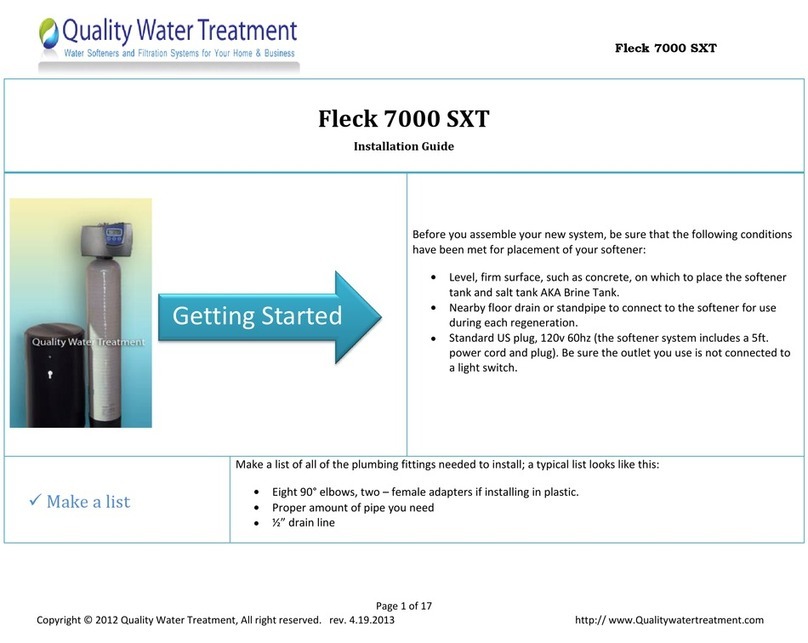
Fleck
Fleck 7000SXT installation guide
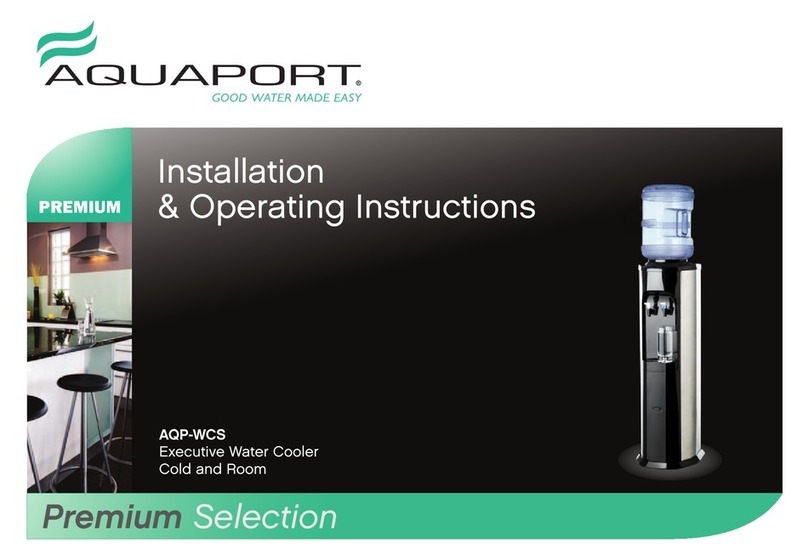
Aquaport
Aquaport AQP-WCS Installation & operating instructions

Premier
Premier FDA-5021 instruction manual

Glacier bay
Glacier bay VWD5446BLS Use and care guide
